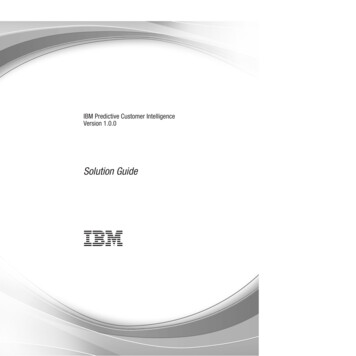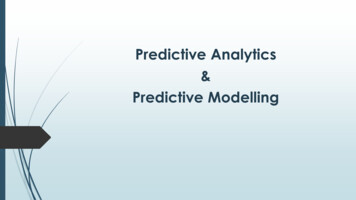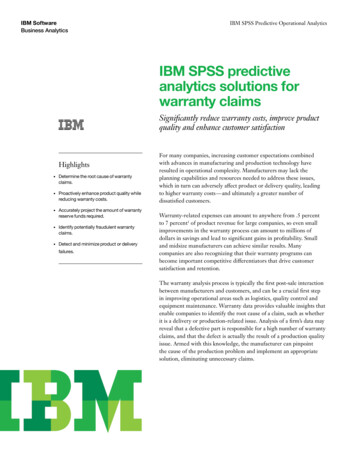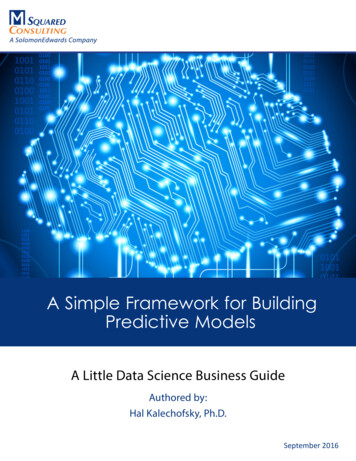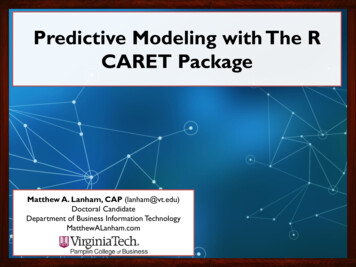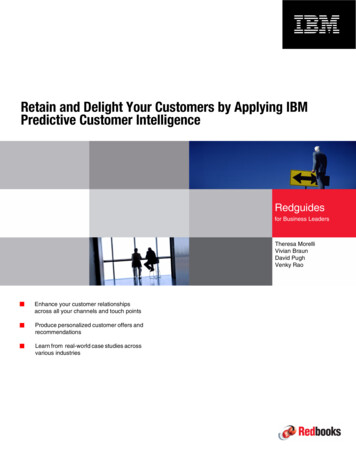
Transcription
Front coverRetain and Delight Your Customers by Applying IBMPredictive Customer IntelligenceRedguidesfor Business LeadersTheresa MorelliVivian BraunDavid PughVenky RaoEnhance your customer relationshipsacross all your channels and touch pointsProduce personalized customer offers andrecommendationsLearn from real-world case studies acrossvarious industries
Executive overviewWhat if you knew which customers would most likely respond to a campaign or marketingpromotion? Or knew which customers are at risk for attrition and if given the chance couldprovide retention offers that significantly reduced the risk of customer attrition? What if youknew the best cross-sell/up-sell opportunities with your customers? What if you and yourorganization knew the best action to take with each customer right now? How would it helpyour business if you knew each customer’s lifetime value? What if you could easily find waysto increase customer repeat visits and grow loyal and profitable relationships? What if youhad a way to deliver a smarter, personalized, seamless customer experience regardless ofthe channel?For many customer-centric organizations, having a solution to these questions would be adream come true. For many organizations, creating positive and memorable customerexperiences is a goal they are still striving toward. The now well established age of theempowered customer has many organizations scrambling to relate to each individualcustomer on their terms with customized offers that fit their needs and desires. Manyorganizations understand that in order to retain, grow, and acquire customers, they mustimprove their interactions with the customer and build strong knowledge-based relationshipswith customers.How to build a strong bond with customers is the central issue. Organizations often lack aconsistent customer relationship strategy that engages both the organization’s businessfunctions and their channels, producing the following limitations: Lacking the ability to use all available customer information during interactions resulting ininappropriate or ineffective offers and communications, inconsistent service delivery, anddistressed customer relationships. Missing the opportunity to use knowledge of past, present, and future events that coulddirectly have an impact on customer value. Providing the customer with inconsistent or different treatments when the customer isusing various channels. This situation could be caused by lines of business operatingindependent of each other. For example, marketing is encouraging customers to makepurchases as quickly as possible. However, order fulfillment is too busy, has limitedinventory, or is understaffed causing the delivery to be delayed ultimately frustratingcustomers.IBM Predictive Customer Intelligence ensures that all interactions with customers arecoordinated, optimized, and effective. IBM Predictive Customer Intelligence gives your Copyright IBM Corp. 2015. All rights reserved.1
organization the ability to quickly sift through a wide range of customer information to provideinsight and determine the most appropriate action for individual customers at critical points inthe customer experience. By having this ability, your organization will be able to maximizecustomer satisfaction and increase sales revenue.IBM Predictive Customer Intelligence brings together in a single solution the ability to do thefollowing activities: Provide a personalized rich 360-degree view of each customer. Determine the best action for each particular customer. Retain customers identified as likely to leave. Microsegment your customers to provide targeted marketing at the individual “market ofone” level. Identify the best time and the most appropriate channel to deliver an offer to a customer,such as email, telephone call, or a message to their mobile device.This IBM Redguide publication introduces the IBM Predictive Customer Intelligence solutionand highlights the business value of the solution. It provides a high-level architecture andidentifies key components of the architecture. The guide includes real-world customer casestudies of implemented solutions in various industries.Facing the new age of the empowered customerIn the paper Empowered Customers Drive Collaborative Business Evolution, Forrester Groupstates, “Delivering an outstanding customer experience has become a strategic imperative.This is true across all roles, and for marketing, customer service, and e-business leadershiproles in particular, delivering on customers’ evolving expectations and keeping up with theiruse of technology has become paramount. In today’s environment, companies are beingforced to adapt their business models, customer experience, and marketing strategies quickly,and our research found a link between companies’ flexibility and willingness to adapt and theirbusinesses’ growth rates.1”Organizations are being confronted by dramatic changes to the way business is performed: Increasingly empowered customerThis empowerment is providing customers with unlimited access to information and theability to share their experience instantaneously. This access is raising expectations of thecustomer with regards to the quality and pricing of products and services and on theeffectiveness of customer support. The relationship between the customer and theorganization has changed dramatically because of the technology in the hands of thecustomer. Limited organizational insightMany organizations are unable to use the information and knowledge of past and presentevents to increase their value to the customer. Without a complete view of the customer,an organization when interacting with a customer can miss potential opportunities. Andwhen key customer information is not shared across organizational areas, the customercan experience inconsistent service delivery, potentially frustrating the customer.1Empowered Customers Drive Collaborative Business Evolution , Forrester Research, Inc, May 2012, found 961D40522U33/Empowered Customers Drive Collaboarative Business Evolution.pdf2Retain and Delight Your Customers by Applying IBM Predictive Customer Intelligence
Empowered customers demand personalized and relevant attentionEmpowered customers want the companies they interact with to anticipate and servicetheir particular purchasing needs. They want convenient and easy ways to interact withcompanies. They want each company to be there when they need them. They wantcompanies they deal with to know them personally in context and to remember all of theprevious interactions regardless of the channel being used. Customers’ expectations areshaped by the best in class, who may operate in a very different industry to yours.In order to influence the new empowered customer, organizations have to strive for theseresults: Deliver an end-to-end solution that is able to consume, integrate, analyze, and score datain order to determine the most appropriate action. This processing must occur for eachindividual customer and their situation. Gather and synthesize insights from analysis of multiple data sources, including social,text, click stream, and transactional customer data to predict customer sentiment andneeds in real time. Combine the complete view of the customer with additional contextual informationgathered at the time of interaction, resulting in appropriate and timely offers andcommunications. Provide consistent service delivery along with building strong customer relationships,resulting in lower customer churn. Provide cross channel integration and integrated lines of business support, enablingconsistent and strategic interactions with the customer. Coordinated marketing offers that provide customer value over a lifetime. Integration of analytics into the organization to provide long-term value and an enhancedlong-term strategy.Customer understanding and insights are critical to decision making at all levels of anorganization. The IBM Predictive Customer Intelligence solution can help provide theknowledge and insight needed to make better decisions concerning customers.The business value of IBM Predictive Customer IntelligenceA comprehensive profile of your customers is required today in order to respond effectively tocustomer requests. This profile is built using data from diverse sources that must be analyzedin tandem. The data may be commonly used structured data and diverse unstructured datathat can be internal and external to the business environment. Given the estimate that over80% of data generated is unstructured, this is a valuable yet often untapped resource.IBM Predictive Customer Intelligence can continuously analyze all of these data types. It canprovide insights and recommendations (based on this data) that are used to create finelytuned customer interactions specific to the customer’s needs. IBM Predictive CustomerIntelligence provides the following benefits: Wide reaching customer insightAfter using IBM Predictive Customer Intelligence to analyze all the pertinent data relatedto each customer, the resulting single view of the customer can be shared across theorganization, feeding into systems of engagement or presented in a manner tailored toeach user’s needs. In essence, IBM Predictive Customer Intelligence enables anorganization to develop an integrated customer insight engine that improves interactionswith the customer.3
Meaningful customer segmentationIBM Predictive Customer Intelligence enables organizations to deploy a wide spectrum ofapproaches to segmentation where a batch approach (as opposed to 1:1 ratio) is required. Understanding individual preferences via dynamic segmentationThe analysis of behavior (for example, preferred communications channel) within adynamic segment fills in the gaps where an individual’s preferences are not fully known. Multi-channel optimizationIBM Predictive Customer Intelligence enables an organization to deliver a seamlessmultichannel experience to the customer, enabling the customer to feel in control of theinteraction. The various channels available for customer access include mobile devicesand phones, chat, and face-to-face. Impeccable customer experienceIBM Predictive Customer Intelligence enables an organization to design a flawlesscustomer experience. By having a comprehensive profile of each customer, anorganization is able to produce a customer experience that emotionally connects thecustomer with the brand.All of these benefits enable the organization to provide the customer with the right interaction(including solutions and offers) at the right time wherever and whenever needed.Making sense of your customer-related dataIBM Predictive Customer Intelligence helps translate all the data and information you haveabout your customers (within and external to the organization) into insights andrecommendations that help the organization understand and effectively interact with eachcustomer. These insights and the ability to take action on those insights can drive long-termcustomer loyalty and value. This solution coalesces customer care strategies across theorganization’s functional areas, such as sales, marketing, customer service, and billing.A holistic and insightful view of the customer is driven by an effort to better understand thecustomer based on all the data, information, experience, and interactions the organizationhas with the customer and that of the broader population of other customers displaying similarbehaviors. This approach includes information that the customer may communicateelectronically about the organization via social media.Figure 1 on page 5 shows moving across the spectrum from the current departmental/siloedview where information can be fragmented and sometimes absent to an improvedenvironment that empowers an organization based on a single cohesive view of the customer.This single view captures key insights from business applications, all customer interactions(past, current, and possibly considering future perspectives), and all data types. Thisapproach drives customer interactions in a proactive fashion. Along with customer service,customer-facing teams in sales and marketing have an aligned, consistent view of thecustomer.4Retain and Delight Your Customers by Applying IBM Predictive Customer Intelligence
Many views of thecustomerPast (historical, aggregated)Present (real time)Future (predictive)Virtually all staff, notjust customer serviceMarketingSalesIT executivesFront-line employeesFROMDifferent decisionsMajor and minorStrategic and tacticalRoutine and exceptionalManual and automatedTOTProactive, multidimensionalview of customer,engagement orientedReactive, siloed, single viewof customer, problemorientedDataMediaContentMachineSocialMany mediaFigure 1 Aligned customer service and marketing approach to the customerIBM Predictive Customer Intelligence drives optimized customer interaction at the point ofcontact based on predicted outcomes and behavior to achieve the wanted results.IBM Predictive Customer Intelligence helps an organization personalize the customerinteraction by applying the most relevant recommendations to each individual customer.These recommendations are generated from advanced algorithms that examine and revealhidden patterns and associations within various types of data, such as buying behavior, webactivity, and social media presence. For a comprehensive approach to understanding andretaining your customers, use IBM Predictive Customer Intelligence to apply the followingconcepts: Identify and segment customersThis approach enables marketing to effectively market to existing and potential customersby knowing the customer, their needs, and preferences. Optimize offers and decisionsWith customer insight, the marketing and sales teams can develop offers that are tailoredto business objectives and respond to the customer’s unique profile. This is accomplishedtypically by having the systems set up for recommended actions to be injected directly intomarketing execution systems and fed to customer-facing associates or to self-servicechannels, such as online stores or mobile apps. Perform market-basket analysisCreate tailored offers reflecting the likelihood of a customer buying a certain item based ontheir purchase history (and that of their peers) and other determining variables. Thisactivity is performed at the point of purchase for up-sell and cross-sell purposes. Engender loyalty and profitabilityGrow customer relationships and attract customers to higher-value segments by informingthem of opportunities to purchase products and services that would likely be of interest tothem, with a deep understanding of their purchase triggers. For example, do not offersomebody a 20% discount if they are predicted to make a purchase at a 5% discount or5
perhaps suggest additional products that appeal to a preference, such as environmentalsustainability. Minimize churn and build lifetime valueProactively decrease churn by being responsive to customer needs and sentiment duringevery interaction. Use Customer Lifetime Value (CLTV) calculations to focus retentionefforts on the highest value customers.IBM Predictive Customer Intelligence in the businessenvironmentIBM Predictive Customer Intelligence can be used by companies to personalize the customerexperience by making relevant recommendations to each individual customer based on a360-degree view of the customer. This solution gathers customer information from multipleinternal and external sources and models customer behavior. Scoring capabilities providecustomized actions that can be taken to provide the right offer to the right customer at theright time through the right channel.Figure 2 provides a view of the IBM Predictive Customer Intelligence within a businessenvironment.Data12IBM PredictiveCustomer Intelligence34MultichannelIBM ExperienceOne &Third-party Marketing Customer InteractionsHOW?Interaction Data Email and chattranscriptions Call center notes Web click-streams In-person dialoguesWHY?Attitudinal Data Opinions Preferences Needs and desiresCampaignsAcquisition ModelsOffersCampaign Response ModelsMessagingChurn ModelsLead ManagementCustomer Lifetime ValueCross-channelCampaign ManagementLifetime Value Maximizer (GBS)WHO?Descriptive Data Attributes Characteristics Self-declared information Geographic demographicsMarket Basket AnalysisPrice SensitivityProduct Affinity ModelsBehavioral Data Orders Transactions Payment history Usage historyInteractiveVoice ResponseMobileAppsShort MessageServiceReal-time MarketingMarketing EventDetectionDigital MarketingSegmentation ModelsWHAT?WebSocial MediaChatSentiment ModelsUp-sell/cross-sell ModelsVoiceEmailFigure 2 IBM Predictive Customer Intelligence in a business environmentIn Figure 2 the following elements are shown: Data (Figure 2, column 1)Data provides the basic inputs for understanding who the customer is, how they interactwith the business, what business they have done to date, and why they purchase goods orservices. The data can be interaction, attitudinal, descriptive, and behavioral in nature.The sources of this data can be internal and external to the company and the data can be6Retain and Delight Your Customers by Applying IBM Predictive Customer Intelligence
structured and unstructured. The interaction data includes historical data, as well as, thehere and now (the context of the interaction). This data provides the basis for IBMPredictive Customer Intelligence to create a 360-degree view of the customer that is usedto make relevant recommendations. IBM Predictive Customer Intelligence (Figure 2 on page 6, column 2)Within IBM Predictive Customer Intelligence are various models that can be deployeddirectly at the point of interaction or point of contact. The models can also be deployed tointeract with IBM and third party marketing systems, outbound marketing, and digitalchannels. The overall goal of IBM Predictive Customer Intelligence is to maximize everyinteraction with the customer, regardless of where and how you are communicating withthem.These models can be tailored and extended to fit the organization’s evolving and uniquerequirements in order to help you confidently recommend a personalized relevantoffer/solution to each customer situation:– Predictive analytics help the organization anticipate the behavior of individualcustomers.– Decision management converts predictive model scoring results into the appropriateactions.– Real-time scoring is used to generate and re-generate predictions on demand.– Cross-campaign optimization identifies the most profitable decisions related to eachcustomer.IBM Predictive Customer Intelligence also features a connector for IBM InfoSphereStreams in order to support high volume streaming data. This integration is important forcustomers that need recommendations for high volumes of transactions within seconds.IBM Predictive Customer Intelligence is not just for outbound marketing campaigns andnot just for customer segmentation. It supports the complete customer lifecycle andenhances the customer interaction and the customer relationship overall. IBM ExperienceOne or third-party marketing (Figure 2 on page 6, column 3)IBM Predictive Customer Intelligence has connectors to IBM ExperienceOne solutions forefficient execution of recommended actions:– IBM Campaign is a web-based solution that enables users to design, run, and analyzedirect marketing campaigns.– IBM Interact provides personalized offers and customer profile information in real-time.– IBM Marketing Platform provides security, configuration, and dashboard features forIBM ExperienceOne products.IBM Predictive Customer Intelligence also integrates with various third-party marketingsolutions that provide services, such as creating and running campaigns, creating offers,messaging, and supporting lead management, cross-channel campaign management,real-time marketing, marketing event detection, and digital marketing. Multichannel customer interactions (Figure 2 on page 6, column 4)The multichannel customer interactions include the various systems of engagement thatcan be used to interact with the customer. IBM Predictive Customer Intelligence willrecommend the best form of engagement based on the organization’s marketingexecution and systems of engagement solutions.The analytic engines that make up the core of IBM Predictive Customer Intelligence are themost strategic and transformational capabilities available for an organization, because theyprovide the richest, most sophisticated analytic techniques. They enable an organization to7
deploy accurate, fact-based, and consistent decisions (interactions) with their customer.These interactions and the resulting positive outcomes directly impact the business. In thisintegrated business environment, an organization can minimize inconsistency and variationsin communications at all customer interaction points.It is important to understand that the organization can clearly define, maintain, and fine-tunethe criteria used to generate these customer-facing decisions and interactions, as often asneeded.IBM Predictive Customer Intelligence high-level architectureIBM Predictive Customer Intelligence can be viewed as a layered architecture. Providing alayered architecture makes it easier for an organization to customize the overall solution to fittheir needs. Figure 3 shows IBM Predictive Customer Intelligence in the context of itssurrounding environment that is represented in three distinct layers.Call CenterEmailSMSWebDigital MarketingMessagingMobile AppsLead ManagementLine of BusinessCustomer FacingChatOPERATIONSAcquisition modelsCampaign response modelsChurn modelsCustomer lifetime valueMarket basket analysis2Price sensitivityProduct affinity modelsSegmentation modelsSentiment modelsUp-sell/cross-sell vioral dataDescriptive dataInteraction dataAttitudinal data1CustomerSystems ofEngagementOffer ManagementEvent Detection3CampaignsDeep historyLarge/complete data setsBroad parametersBig DataPlatformINFORMATIONFigure 3 IBM Predictive Customer Intelligence in surrounding environmentFigure 3 shows the three layers as follows: Information (Figure 3, layer 1)This big data platform manages a wide variety of data and information related to eachcustomer. The platform can deal with various data including behavioral, descriptive, andattitudinal data, data from interactions, historical data, large and complete data sets, andbroad parameters.The platform includes the following capabilities:– Capture, maintain, and analyze various types of data in motion (streaming data) intheir original format.– Provide deep insights based on advanced in-database analytics.– Analyze large volumes of data at rest to gain insights. The data includes social mediadata, emails, web logs, and other types of documents. Data can be analyzed in itsnative format, without imposing a schema or structure, enabling fast ad hoc analysis.8Retain and Delight Your Customers by Applying IBM Predictive Customer Intelligence
– Store and perform analytics on a large volume of current and historical structured data,such as customer data, transactions relating to the customer, product information, andany formalized customer-related activity.– Perform master data management (MDM) that provides a single view of customers,products, services, and assets.– Provide information integration that includes moving, transforming, and remediatinginformation as it flows between the various layers. Analytics (Figure 3 on page 8, layer 2)IBM Predictive Customer Intelligence has an extensive set of predictive modeling andanalytic capabilities that provide insights and recommendations to the customer-facingbusiness units within an organization and to systems of engagement. During customerinteractions, IBM Predictive Customer Intelligence helps optimize those interactions andimproves the customer experience.Predictive models are designed to bring predictive intelligence to decisions. They candiscover hidden relationships in volumes of structured and unstructured data. Theserelationships and insights are used to make recommendations during customerinteractions. For example, predictive models can be used to determine the likelihood of afuture customer purchase based on factors, such as customer age, browsing, andtransaction history.IBM Predictive Customer Intelligence contains various industry-specific modelingcapabilities, such as customer acquisition, campaign response, churn, CLTV,market-basket, price sensitivity, product affinity, segmentation, sentiment, andup-sell/cross-sell models. These capabilities were developed based on extensiveengagements with organizations over the years. Operations (Figure 3 on page 8, layer 3)Operations encompass all the line-of-business customer-facing teams and systems thatsupport and engage with the customer. These systems can be provided by IBM orthird-party providers. IBM Predictive Customer Intelligence integrates with these systemsproviding key information that the teams and systems use in their customer-facingprocesses to improve marketing, sales, and customer service outcomes.To explore IBM Predictive Customer Intelligence in more detail, Figure 4 on page 10 showsthe core capabilities of IBM Predictive Customer Intelligence.9
Points ofInteractionIBM Predictive Customer IntelligenceModel RepositoryValue & ep customeranalyticsActionablecustomer dataPredictiveModeling4Segmentation SentimentModelAnalysisReal-timeScoring6Up-sell /cross-sell ModelAcquisitionModelCampaignResponseModelExplore newDcustomer2 insights from alldataD3Master DataMgmt(trustedcustomer data)52CLTVMarket ory forReal-timeAnalyticsIBMExperienceOneandthird 1 Customer LifetimeProductAffinityModelC2 Streaming data ingestion and processing withreal-time analyticsFigure 4 Core IBM Predictive Customer Intelligence componentsIBM Predictive Customer Intelligence (shown in Figure 4) has the following core capabilities: Predictive modeling (Figure 4, item 1)Predictive models are designed to bring predictive intelligence to decision making. Themodels can discover hidden relationships in volumes of structured and unstructured dataand provide scoring to determine which is the optimal of many potential actions. Theserelationships and insights are used to make recommendations during customerinteractions. Reporting (Figure 4, item 2)Reporting tools are available that enable management and customer-facing teams totrack, analyze, measure, and report customer interactions and marketing campaignresults across all channels, markets, and customer segments. Powerful visualizationsenable the teams to share insights and act on findings to better respond to customers anddrive action. The reports can be integrated within the organization’s enterprise businessintelligence solution. Model repository (Figure 4, item 3)IBM Predictive Customer Intelligence provides an extensive set of modeling capabilitiesthat support customer-facing teams within an organization. These models areindustry-specific, minimizing the time needed to take advantage of IBM PredictiveCustomer Intelligence. Sophisticated statistical and analytical algorithms are used tocreate the models, which include:– Segmentation model supports customer segmentation (based on transactional data).The models form the basis for optimizing sales and marketing processes and provide afoundation for other predictive analytics.– Churn (retention) model provides the means to identify which customers are at risk ofleaving, to understand ways to increase retention, and to focus immediate interventions10Retain and Delight Your Customers by Applying IBM Predictive Customer Intelligence
on customers who might stay. The model uses data to find similarities and differencesbetween customers who canceled versus those who stayed. These models can helpimprove or drive customer loyalty programs.– Acquisition model helps focus on marketing efforts by understanding which prospectsand customers are the most likely to purchase product and services. The results of thisanalysis are the basis for marketing programs focused on those individuals.– Customer lifetime value (CLTV) segmentation classifies customers and providesrecommendations on ways to retain customers based on their lifetime value to theorganization.– Price sensitivity measures at specified levels how pricing will affect the volume of salesthat is also basis for predicting product demand (based on the product price). Bothmoving average and lag variables capture sensitivity changes that are derived from atime series of purchase data and other indicators of developing or diminishing pricesensitivity based on various constraints.– Sentiment analysis takes content from social media such as Twitter to understandparticipants view of or attitude toward something such as a situation or event.– Up-sell/cross-sell model is based on association modeling. The results of this modelingcan be used to make targeted recommendations of items that could be of value/interestto the customer. Multiple campaigns and business constraints can be scanned to findthe best assignment of customers to campaigns. Also, the logic of business rules canbe combined with the insight gained from predictive modeling to further improve themodel.– Campaign response model based on analytics is used to determine which customersare most likely to respond positively to a marketing campaign.– Market basket analysis can be used to increase marketing effectiveness and toimprove cross-sell and up-sell opportunities by making the right offer to the customer.For example, a retailer cr
multichannel experience to the customer, enabling the customer to feel in control of the interaction. The various channels available for customer access include mobile devices and phones, chat, and face-to-face. Impeccable customer experience IBM Predictive Customer Intelligence enables an organization to design a flawless customer experience.
